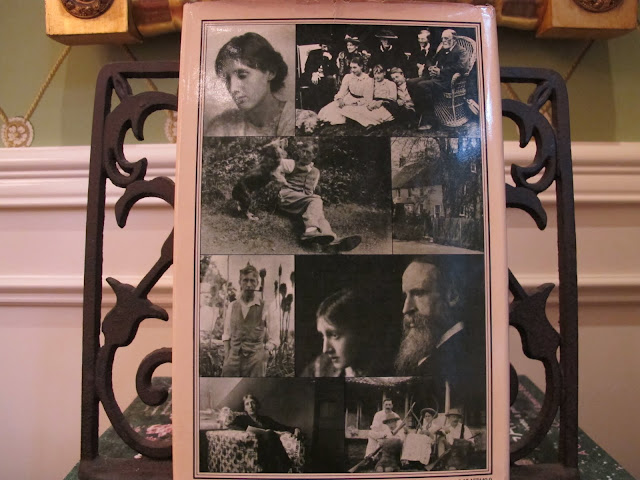Remember this book? "A Marriage of True Minds," published in 1977, is about the relationship and marriage of Virginia and Leonard Woolf. It was one of the first books of its kind on Bloomsbury, and specifically the Woolfs. The other one that comes to mind is "Portrait of a Marriage" by Nigel Nicolson about the marriage of his parents, Vita Sackville-West and Harold Nicolson. This first edition of one of my favorite books was a birthday present from a very dear friend.
The back of the dust jacket
This book was part of an explosion of books on Virginia Woolf and the Bloomsbury Group in the 1970's. I have always thought that the intense interest in Virginia Woolf at that time was a result of Women's Studies departments that originated at colleges and universities in the early 1970's.
During the 1970's Quentin Bell wrote his excellent biography of Virginia Woolf, and Nigel Nicholson edited all six volumes of "The Letters of Virginia Woolf." Critical studies were coming out as well as additional biographical materials.
What made "A Marriage of True Minds" stand apart was that it was about Leonard, Virginia, and their relationship. Recently I reread some of the book. There were three topics that fascinated me about the story of the courtship and marriage of Virginia and Leonard Woolf.
The role of the "Apostles" --
This was the famous undergraduate society at Cambridge that Leonard Woolf belonged to. It generated the friendships and relationships that led to Virginia meeting Leonard. Other members of this intellectual group included Saxon Sydney-Turner, John Maynard Keynes, Lytton Strachey, E.M. Forster, Roger Fry and Desmond MacCarthy. Virginia's brother Thoby Stephen was at Cambridge at the same time, though he was not a member. But he was friends with many of the "Apostles" and introduced them to Virginia and her sister Vanessa. The Bloomsbury Group was born out of these friendships. Virginia married Leonard and Vanessa married Clive Bell, who was also part of this circle of friends.
Lytton Strachey as matchmaker --
He was very instrumental in bringing together Virginia and Leonard. He planted the seed in Leonard's mind and wrote Leonard, who was in India at the time, many letters encouraging him to marry Virginia. Lytton proposed to Virginia also, but changed his mind almost immediately.
Leonard as caretaker --
He really held Virginia together in terms of her mental stability. After their marriage in 1912, Virginia had a mental breakdown that lasted for two years. After this she experienced fairly good mental health for the next 25 years. This was due to Leonard's care and protection. He insisted on rest, a good diet, a limited amount of socializing and healthy activities, such as learning how to print books on the printing press he bought her, to provide distraction from the intensity of the writing of her novels. This printing press was the beginning of the Hogarth Press, the publishing company that Virginia and Leonard Woolf founded.
This was the famous undergraduate society at Cambridge that Leonard Woolf belonged to. It generated the friendships and relationships that led to Virginia meeting Leonard. Other members of this intellectual group included Saxon Sydney-Turner, John Maynard Keynes, Lytton Strachey, E.M. Forster, Roger Fry and Desmond MacCarthy. Virginia's brother Thoby Stephen was at Cambridge at the same time, though he was not a member. But he was friends with many of the "Apostles" and introduced them to Virginia and her sister Vanessa. The Bloomsbury Group was born out of these friendships. Virginia married Leonard and Vanessa married Clive Bell, who was also part of this circle of friends.
Lytton Strachey as matchmaker --
He was very instrumental in bringing together Virginia and Leonard. He planted the seed in Leonard's mind and wrote Leonard, who was in India at the time, many letters encouraging him to marry Virginia. Lytton proposed to Virginia also, but changed his mind almost immediately.
Leonard as caretaker --
He really held Virginia together in terms of her mental stability. After their marriage in 1912, Virginia had a mental breakdown that lasted for two years. After this she experienced fairly good mental health for the next 25 years. This was due to Leonard's care and protection. He insisted on rest, a good diet, a limited amount of socializing and healthy activities, such as learning how to print books on the printing press he bought her, to provide distraction from the intensity of the writing of her novels. This printing press was the beginning of the Hogarth Press, the publishing company that Virginia and Leonard Woolf founded.
********
These two as a couple and individually had an enormous impact on early twentieth-century British literature. Virginia wrote her famous novels, including "Mrs. Dalloway," "To the Lighthouse," and "Orlando." Leonard wrote fiction (short stories and novels) and non-fiction, including his autobiography and frequent articles on politics for many different newspapers and magazines. His reports for the Fabian Society in 1916 on international government became part of the basis for the League of Nations. And together they published many important and groundbreaking works at the Hogarth Press, including T.S. Eliot's "The Wasteland."
It makes you wonder if the two of them would have been as productive were they not married. They provided support, inspiration, and caring for each other and also shared an impressive work ethic. Perhaps that was the secret to their relationship. They had mutual respect and regard for each other as people and for the enormously important work they both were doing.
It makes you wonder if the two of them would have been as productive were they not married. They provided support, inspiration, and caring for each other and also shared an impressive work ethic. Perhaps that was the secret to their relationship. They had mutual respect and regard for each other as people and for the enormously important work they both were doing.







.jpg)




